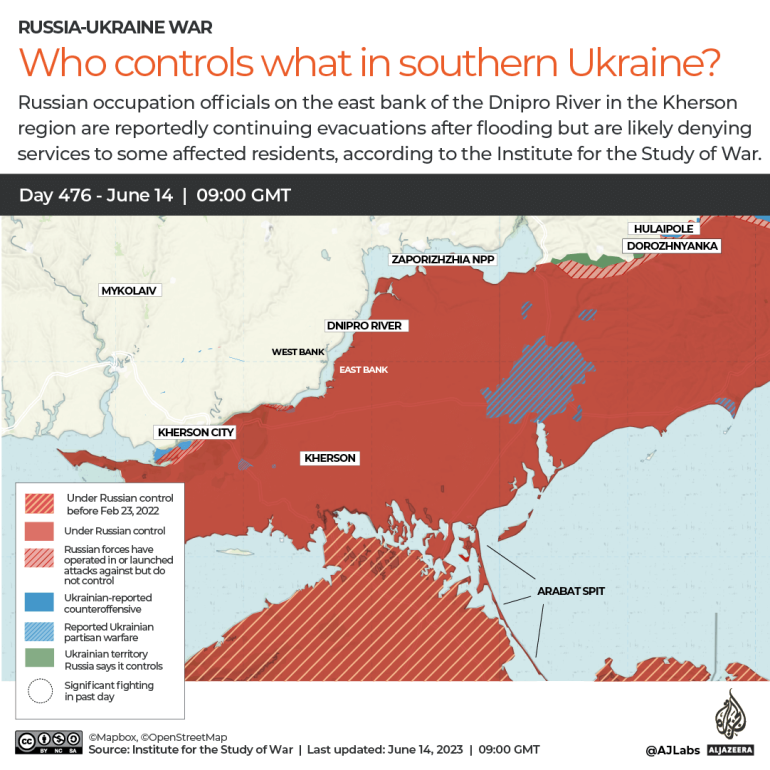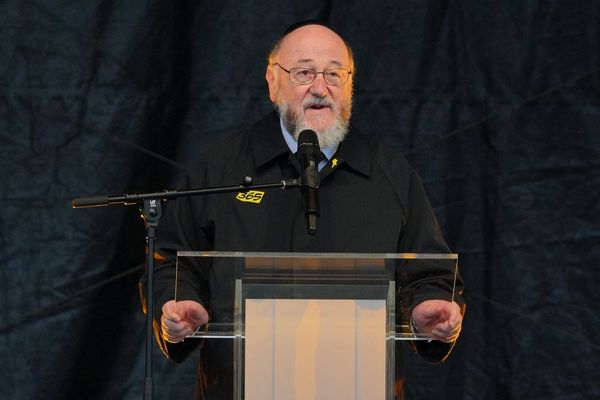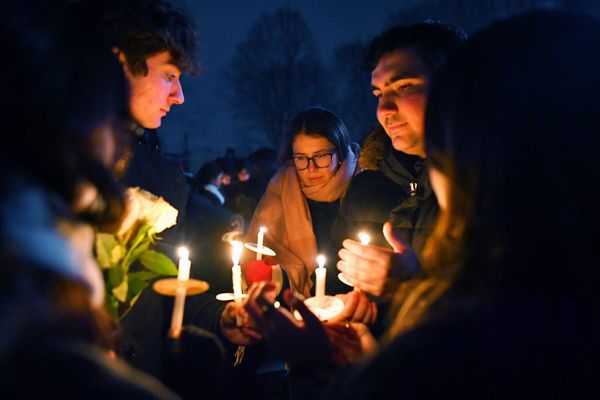
Ukraine says it has recaptured about 100 square kilometres (40sq miles) of its territory during the 68th week of Russia’s invasion as a long-planned counterattack gains momentum.
But Russian President Vladimir Putin said Ukraine was suffering “catastrophic” losses and Kyiv’s casualties were 10 times greater than Moscow’s.
“All counteroffensive attempts made so far have failed, but the offensive potential of the troops of the Kyiv regime is still preserved,” said Putin.
The counteroffensive is still in its early days, said Demetries Andrew Grimes, a former commander who spent two years retraining the Ukrainian military from 2015 to 2017.
“All we’re seeing right now is softening of the [Russian] front lines with harassment fire with everything from small arms and rockets to drones and artillery,” Grimes told Al Jazeera.
“The aim of that is to stretch out the opposition to thin their forces… they’re lengthening the conflict zone and forcing the Russians to expose their supply lines so those can be disrupted and [Ukrainian forces] can encircle smaller groups.”
Ukraine stepped up attacks along much of the 1,200km (745-mile) front. Russia’s defence ministry said it repelled four Ukrainian ground attacks in the Kreminna area of the eastern Donetsk region on June 9.
Further south, eastern forces spokesman Serhiy Cherevatyi said Ukrainian forces advanced by 1,200m (3,940 feet) around Bakhmut on June 9, and by 1,400 metres (4,600 feet) the following day. Russian military sources corroborated these advances.
Ukrainian forces also launched a new front where Donetsk meets the Zaporizhia region on June 9.
Russia’s defence ministry said initial attacks were repelled, but two days later the Washington-based Institute for the Study of War (ISW) said “geolocated footage and Russian sources indicated that Ukrainian forces liberated multiple settlements… [near] Velyka Novosilka in western Donetsk Oblast”.
It is here that Ukraine made most of its territorial gains – 90sq km (35sq miles) – said Deputy Defence Minister Hanna Maliar.
A bold offensive
Perhaps the boldest attack of the counteroffensive took place in western Zaporizhia, south of Orikhiv, where Russian lines were known to be heavily defended.
Russian Defence Minister Sergei Shoigu said a force of 1,500 Ukrainian soldiers with 150 armoured vehicles attempted to break through Russian lines overnight on June 8.
“A preventive strike was delivered by artillery, aviation and anti-tank weapons. In all four directions, the enemy was stopped,” said the Russian defence ministry, reporting Ukrainian losses of 30 tanks and 350 men.
According to Russian military reporters, a “high-intensity battle” took place in which “the enemy fires continuously from artillery and tanks”.
The reporters said the Ukrainian assault had initial success. “The second wave by 5 in the morning led the enemy to a small success, they occupied one height,” said one.
“Our soldiers of the heroic company of the 291st regiment, under strong pressure, withdrew from the front line of trenches to reserve positions, the enemy continuously hit these trenches 3 hours before the offensive from all types of weapons,” they reported, but “the 291st regiment repelled all enemy attacks and returned [to] ALL positions.”
On June 12, Russian forces went on the counteroffensive on this front, said Russian military reporters.
Ukraine’s general staff reported high Russian fatalities – 1,000 on June 8 and 900 on June 10.
Al Jazeera was not able to independently verify the claims.

Transitioning to regular warfare
Ukraine has won media attention for deftly destroying thousands of Russian heavy vehicles throughout the war. The Orikhiv offensive brought rare negative publicity and a separate probe south of Mala Tokmachka also fared badly.
Defence reporter Thomas Theiner pointed out the Mala Tokmachka column lacked air support and was vulnerable to being spotted. “At least three Russian drones and one helicopter flew above the Ukrainians and walked Russian artillery in,” he wrote on Twitter.
Grimes said these are the lessons of a military relearning to fight regular mechanised warfare after years of successfully using guerrilla tactics.
After Russia’s invasion of the Donbas and annexation of Crimea in 2014, “Ukrainians realised they might not have the resources they need to rebuild their army and navy and air force, and got to work right away building their special operations capabilities, their counterinsurgency capabilities, as well as training a resistance,” said Grimes.
“The navy pretty much transformed into a marine and coastal defence force, and their army and other forces basically transitioned into special operations and asymmetric-type operations.”

In addition to these operations by Ukraine’s forces, the country’s NATO allies provided more than 250 tanks and thousands of armoured vehicles, and retrained nine brigades to fight pitched battles.
“When you transition into conventional warfare you lose some of that asymmetrical advantage,” said Grimes. “With the capabilities of larger military hardware you … have to dedicate forces to defend those assets. It makes you less flexible,” he said.
The Institute for the Study of War said: “Ukraine’s counteroffensive will likely consist of many undertakings of varied size … and the smaller efforts do not represent the maximum capacity of Ukrainian numbers or effectiveness.”
The ISW said Ukraine had prepared 12 offensive brigades and had committed “only a portion of the large reserve forces available” to western Zaporizhia.
Russia benefits from breached dam
The only region where Ukraine didn’t launch an attack was Kherson, which was flooded after the Nova Kakhovska dam was destroyed on June 6.
Ukraine’s environment ministry said more than 14 cubic kilometres of water, almost three-quarters of the Nova Kakhovska dam’s reservoir, had spilled out, flooding 600sq km (232sq miles) of Kherson.
It is still unclear which side targeted the dam with Russia and Ukraine accusing each other of blowing it up.
‘Battles are fierce’
Ukrainian Deputy Defence Minister Oleksandr Pavlyuk said it was a defensive tactic.
“I think the enemy wanted to ensure the security of their left flank. Having blown up the dam, they created a barrier line and thereby prevented our offensive from this side,” he said.
Grimes said Russian forces learned the tactic from Ukrainian forces defending Kyiv in the early weeks of the war.
“The Ukrainians on the outskirts of Kyiv flooded a lot of the fields with water so that they forced the Russians’ heavy armour and trucks to manoeuvre on higher and more solid ground and targeted them more effectively,” he said.
Ukraine’s southern forces spokesperson Natalia Humenyuk said flooding had obliged Russian forces to withdraw 5km-15km (3-9 miles) from their forward positions, leaving behind equipment. As a result, Russian shelling had almost halved.
The flooding led to minefields being washed away and mines were being found in the Black Sea.
Russian forces also abandoned the Dnipro Delta.
Despite the setback in Kherson, Ukrainian President Volodymyr Zelenskyy said he was satisfied with progress in other regions.
“The battles are fierce but we are moving forward, and this is very important. The enemy’s losses are exactly what we need,” said Zelenskyy in a video address.









